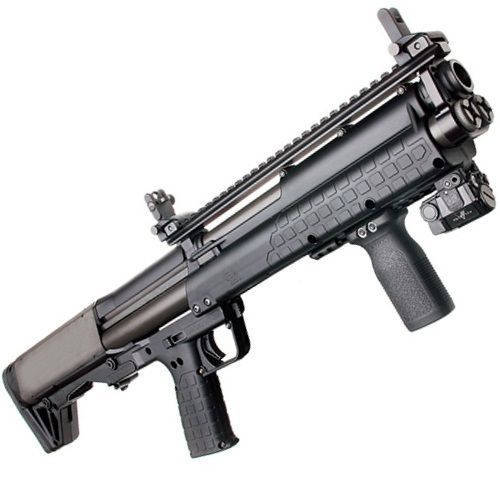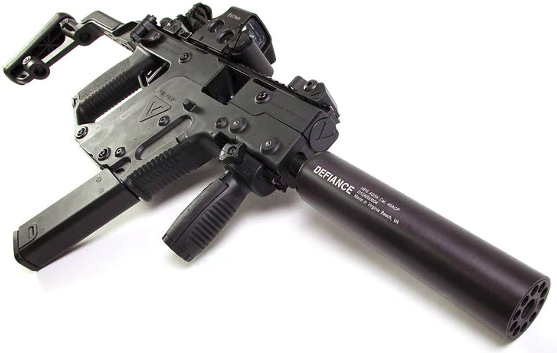Firearms for Home Defense

If you’re mentally and physically prepared to use lethal force in self defense and it's legal to do so in your jurisdiction, you should certainly consider firearms as a means of securing the safety of yourself and your family while at home. This decision comes with plenty of pros and cons and it's not for everyone. However, it's hard to overstate the force multiplier that a firearm provides. By this I mean that a person who is not in peak physical condition or highly trained in hand to hand combat can easily put themselves at an advantage against a physically stronger opponent or even multiple attackers.
Defensive use of firearms is not well documented, though estimates are that 500,000 to 3 million incidents occur in the U.S. every year. Fewer than 10% of defensive firearm use involves actually firing the weapon — the vast majority of the time, merely brandishing the firearm is sufficient deterrent to send an attacker running.
Note that firearms are not as effective as you may believe - they do not guarantee that an attacker will be stopped immediately. While the average encounter in which a firearm is used results in about 3 rounds being fired, this is only the average and you want to be prepared for extremes. Once again, there are many videos online that show the range of outcomes from a single shot ending the attack to an entire magazine of rounds being deployed against a subject before they are incapacitated.
WARNING: the following footage contains GRAPHIC CONTENT, but it drives home the point that bullets are not magic. There are many such videos that can be found online.
There are several considerations when it comes to home defense firearms:
- Avoid overpenetration—you don't want a round to go through a wall (or multiple walls) and impact a family member, friend, or neighbor who is in another room or even another building. Know what the walls of your building are made of—if they are common drywall material then you definitely need to be careful with your selection of ammunition. Buckshot and lower velocity pistol rounds are generally preferable, but it can vary widely based upon the ammunition construction. If you purchase frangible ammunition then it will drastically reduce overpenetration. Any effective defense round with enough power to penetrate a human body will have sufficient velocity to penetrate drywall . If the only concern was to not penetrate walls, we'd use air rifles, rock salt, or bird shot. However, none of those will stop a human. You can find a ton of drywall penetration tests at The Box O' Truth.
- Avoid long guns that make it difficult to clear tight corners and spaces. The last thing you want is for an intruder to disarm you because they were able to ambush you while coming around a corner.
- Flashlights and lasers are worth it; you want to have a weapon that can find a target in low light conditions. A caveat is that if you're walking around with a flashlight at night, an armed attacker may decide to fire at the source of the light. As such, it's a good idea to have a firearm-mounted flashlight that is easy to flick on and off as needed. Bonus points if your flashlight has a strobe function that can confuse anyone on the receiving end.
- Large viewing window holographic or reflex sights make target acquisition fast and natural. These reflector sights reduce parallax to nearly zero, allowing you to shoot the weapon with both eyes open without requiring the firearm to be perfectly perpendicular to your eye.
- Higher magazine capacity is preferable. While most engagements with firearms only result in ~3 rounds being fired, you want to be prepared for any scenario including a prolonged gunfight. Reloading while under stress is something you'll want to avoid unless you are strict about training often to build up muscle memory. Also, you don't know what condition you'll be in when you find yourself defending your home. You may not even be wearing clothing that is suitable for carrying extra magazines!
- Suppressors are highly underrated—and not for aiding assassins, but for hearing protection! If you find yourself needing to use a firearm to defend yourself against a home invader, you're not going to bother putting hearing protection on your ears. Plus, such hearing protection would be a tactical disadvantage, making it difficult to hear both friend and foe alike. On the flip side, if you fire a gun inside of an enclosed space without any hearing protection, you will be nearly deaf for the next couple minutes. Funny how folks in movies and TV shows never seem to have that problem...

My home defense weapons are stored in quick access safes, loaded with a round in the chamber and with safeties disabled. Choose the storage method that is right for you and your family – but you probably don't want to have to perform any steps other than aiming and pulling the trigger if you're in a high-stress, life-and-death situation. When seconds matter, keep it simple - the other alternative is to spend enough time training that more complex actions become ingrained as muscle memory.
Firearm Training
While there are many considerations to make regarding use of firearms, the most important is that you should not simply buy a gun if you're just going to lock it in a safe and never touch it. Like any tool it requires maintenance, which includes maintaining your own familiarity with it. Without proper training, use of a firearm can easily complicate a life or death situation instead of solving it. You should be willing to seek out and sign up for several training courses at a local range, both for basic firearm handling knowledge and specifically for home defense tactical knowledge. You should also be willing to dedicate at least a few hours every few months for visits to a shooting range so that you remain familiar with the operation of your weapons and are able to quickly recover from common weapon malfunctions.
You'll also want to be familiar with the "Tueller Drill" and the "21 foot rule." This is all about reaction times and realizing that a firearm does not immediately stop a threat.
I also recommend you learn from real-life self defense situations; there is a great archive with hundreds of surveillance videos from deadly encounters available on Active Self Protection's YouTube channel. The host does a great job breaking down each encounter and what lessons should be learned as a result.
Firearm Safes
I recommend storing multiple firearms in a decentralized system of quick access safes that can be opened in 1 or 2 seconds. Just think about where you spend the most time in various parts of your house and where you could put a safe that would be accessible in a matter of seconds if you heard someone break in. If you only have one safe, you'd hate to end up in a situation where an intruder is between you and the safe.
I’d steer clear of fancy electronic biometric safes and stick to quick access mechanical safes. Years ago I owned a GunVault Multivault which worked well until it didn't. I had to remember to replace the batteries annually, then after 3 or 4 years the internal door release wire snapped, making the electronic unlock motor useless. My favorite quick access safes that have withstood a decade of use are the Fort Knox pistol and rifle boxes. There are no batteries that can die and there are few moving parts than can fail—reliability is a must when it comes to self defense!
Recommended Firearms for Home Defense
The first rule of choosing a firearm is that you should use the one with which you are most comfortable. It's better to not have a firearm than to have one you can't operate easily. "Try before you buy" can be tough to do with guns, but if there's a shooting range near you that has a wide variety of firearms for rent, give them a visit! Personally, with the criteria above in mind, my personal preference is for one of the following:

The KSG is an interesting shotgun. It holds 14+1 rounds of 2.75" 12 gauge shells in two different tubes. If you want to go crazy, you can buy 1.75" Aguila Mini Shotshells and load 12 into each tube for a total of 25 rounds! Another neat feature is that since there are two shell tubes you can load two different types of ammo and switch to what you want as needed. With regard to selection of shell loads, don't go too exotic as you might have to end up answering why you chose a certain load in court. 00 buckshot is your best bet.
Since the KSG is a bullpup design the 18.5" barrel doesn't stick out nearly as far from your body as a shotgun with a traditional stock does—this makes it better for clearing tight spaces.
One word of warning though: the KSG can be finicky at loading new rounds if you don't rack it swiftly and soundly. You can easily end up "short stroking" and failing to load a new round. In order to reduce the likelihood of short stroking, I recommend adding a vertical foregrip as shown above. But, second word of warning: don't buy a cheap plastic foregrip! There have been reports of users who energetically fired multiple rounds and broke the foregrip off while pushing it forward, then pulled the trigger while their hand was in front of the barrel!

The Kriss Vector is technically a pistol. However, with the right modifications, you'll have a weapon that's far superior to your average handgun.
The Vector is unique in its bolt design— instead of simply blowing back upon firing a round, the bolt travels in a "V" shape and helps to mitigate recoil, enabling faster target re-acquisition for follow-up shots.
The Vector also accepts Glock magazines, so you can get an extended magazine that holds 25+ rounds depending upon the caliber.
The Vector also has a threaded barrel that's easy to screw a suppressor onto. Note that while this is technically a pistol and suppressors often need special adapters for pistols, that is not the case for the Vector. For suppressor purposes, treat it like a rifle because it has a fixed barrel.
The biggest choice with the Vector is which caliber round to choose. Personally I recommend .45 because it's a naturally subsonic round, meaning that a suppressor will be far more effective than on any other pistol caliber rounds. Also, .45 tends to overpenetrate less than other rounds because it's a larger bullet that transfers more of its energy into whatever it impacts.
With regard to ammunition selection, general consensus is that it's best to use a common brand name hollowpoint defense round such as Speer Gold Dot, Federal Classic Hydra-Shok Personal Defense, or Remington Golden Saber. Hollowpoints both inflict more damage and slow down more upon impact because they expand into a wider "mushroom" shape.
In Closing
Preparing for potentially life threatening situations is a touchy subject for many people; ultimately only you can decide what level of security you need and what level of resources you're willing to commit. The vast majority of firearm owners will never need to use a weapon in self defense, nor do they have any desire to do so. Firearms should be the last line of defense in any home security setup; to see my recommendations for other layers of home security, check out this post.




